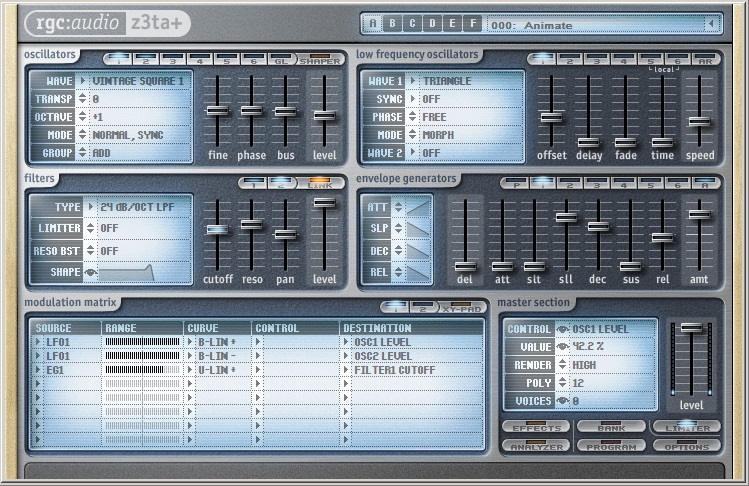Why be normal? Create your own signature sound from sample-based instruments with a little editing
Sometimes even a simple parameter change or two is all you really need to customize a sound to fit your needs. Like what, you say? Well, like…
LFO WAVEFORM CROSSFADES
Using an LFO to crossfade between two waves (each must be followed by its own DCA), as shown in the screenshot above, provides a less static, more animated sound if you choose related waveforms (e.g., two different organ sounds, 5% and 50% pulse waves, two different basses, etc.). Note that you may need to tweak the oscillator levels a bit so that there’s no significant level variation between the two.
A PEAK EXPERIENCE
Synths can often generate strong peaks, and unless you tame them, they may create havoc when recording. Proper synth programming can help; for example, even though detuned (chorused) oscillators sound fat, there’s a substantial output boost when the chorused waveform peaks occur simultaneously. To reduce this, drop one oscillator’s level about 30% – 50% compared to the other. The sound will remain fat, yet the peaks won’t be as drastic.
High-resonance filter settings are also a problem if you hit a note at the filter’s resonant frequency. Try adding a limiter at the output to cut peaks down to size (use as fast an attack as possible).
VELOCITY PANNING
Having an LFO pan an instrument sound back and forth is usually pretty gimmicky (although this can work with short percussive sounds, as you don’t hear them long enough to detect an audible sweep). However, one panning technique can sound quite natural: Modulate panning with velocity. When you first hit a note its stereo position will depend on the velocity, but as it sustains, it will retain its location in the stereo field until replayed.
WHY SINE AND TRIANGLE WAVES DESERVE RESPECT
Do you think sine and triangle waves are the most boring waveforms in the world? They actually have many uses. For a fuller acoustic guitar or piano sound, layer a sine wave along with the lower notes. To attenuate the sine wave at higher notes, modulate the wave’s amplitude negatively according to keyboard note position (i.e., the higher you play on the keyboard, the lower the level). Also keep the overall level low — just enough to provide a subtle psycho-acoustic boost.

In fact, sine and triangle waves can add more depth to almost any sample because digitally-generated waveforms can have more presence than digitally-recorded sounds. For example, harp samples may lack a bit of “you are there” presence due to mic limitations, room acoustics, etc. Layer a triangle wave with the harp (adjust the triangle’s amplitude envelope so that it “tracks” the harp); the triangle wave provides presence, while the sample provides detail and realism. Initially set the triangle wave level to 0, then bring it up slowly to taste. Keep it subtle — we’re talking background reinforcement, not something obvious.
Here’s another triangle trick: To add some male voices to an ethereal female choir, layer a triangle wave tuned an octave lower. This gives a powerful bottom end that sounds like guys singing along. To maintain the ethereal quality in the upper registers, consider modulating the triangle wave amplitude according to keyboard position so that the triangle wave is not apparent on higher notes.
MORE RESPONSIVE PARAMETERS
“Doubling” modulation routings can make a parameter more responsive. For example, most keyboards have a global pressure control, adjustable for heavy, light, or moderate action. I usually choose moderate, but occasionally need a patch to have a lighter, more responsive feel. Assigning pressure twice to the same parameter (such as overall level or filter cutoff; most parameters can accept more than one modulation source) increases the sensitivity for just that parameter. The controllers will sum together, thus creating more change for a given amount of pressure. This same trick works for velocity.
STRONGER ATTACKS
To strengthen an instrument’s attack, take advantage of the fact that bass sounds (slap bass, synth bass, plucked acoustic bass, etc.) tend to have fairly complex attacks. Transpose the bass wave up an octave, and layer it behind the primary sound. You’ll probably want to add a fairly rapid decay to the bass so that its sustain doesn’t become a major part of the sound.
BETTER STRINGS THROUGH LAYERING
String synthesizers of the 70s, based on sawtooth or pulse waves, created rich, syrupy string sounds that weren’t super-lifelike, but nonetheless sounded pretty cool. Sampled strings may sound more realistic, but often lack the smoothness of analog simulations. For the best of both worlds, dial up a sawtooth or pulse wave, and adjust its envelope for as realistic a string sound as possible. Now layer it behind a string section sample, and the synthesized waveform will “fill in the cracks” in the digital waveform.
PITCHED PERCUSSIVE TRANSIENTS
Percussion instruments, when played across a keyboard, acquire a sense of pitch. Layering these with conventional melodic samples can yield hybrid sounds that are melodic, but have complex and interesting transients. Cowbell is one of my favorite samples for this application. Claves, triangle dropped down an octave, struck metal, and just about any other pitchable percussion can also give good results.
The above suggestions are just the tip of the iceberg. Sample playback synths can be a rich source of sounds that exceed your expectations, but you have to get in there and do some parameter value tweaking. Go ahead and mess around — you have nothing to lose but sounds that are like everybody else’s.
